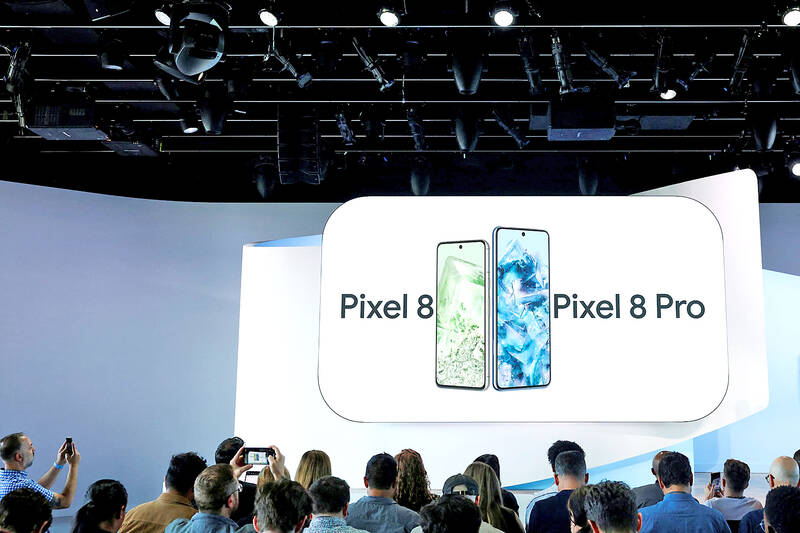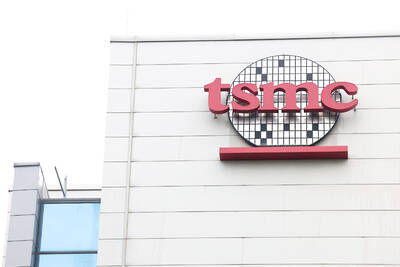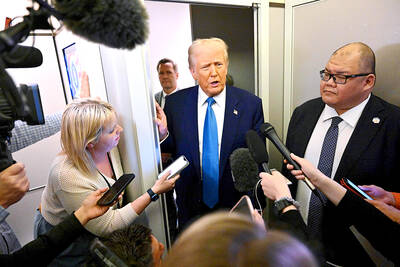Google plans to manufacture its flagship Pixel 8 smartphone in India, Google chief executive officer Sundar Pichai said on Thursday, joining a growing list of global technolgy companies limiting their supply chains’ dependence on China.
Pichai’s announcement follows US rival Apple Inc’s release last month of its latest iPhone, including units made in India, as technology giants target the South Asian nation’s fast-expanding market and abundant supply of cheap skilled labor.
“We shared plans at #GoogleforIndia [event on Thursday] to manufacture Pixel smartphones locally and expect the first devices to roll out in 2024,” Pichai wrote on X.

Photo: Reuters
Pichai added that Google appreciated the “support for Make in India” — a flagship policy of Indian Prime Minister Narendra Modi’s government, offering faster business clearances and financial incentives for manufacturing goods in the nation.
New Delhi has ramped up its production and exports of mobile phones and other electronic goods since the scheme was introduced.
India’s mobile phone exports almost doubled to US$8.5 billion year-on-year in 2022-2023, official figures showed.
Google senior vice president Rick Osterloh said that the firm sees “an even greater opportunity to make Pixel smartphones available to more people” in India.
“In recent years, India has established itself as a truly world-class hub for manufacturing, resulting in a thriving environment for businesses to flourish,” Osterloh said in a statement.
The company intends to “start with the Pixel 8, and will partner with international and domestic manufacturers to produce Pixel smartphones locally,” the statement said.
India, which is home to the second-highest number of smartphone users in the world after China, has set a target of producing about US$300 billion of local electronics and smartphones by 2025-2026.

When an apartment comes up for rent in Germany’s big cities, hundreds of prospective tenants often queue down the street to view it, but the acute shortage of affordable housing is getting scant attention ahead of today’s snap general election. “Housing is one of the main problems for people, but nobody talks about it, nobody takes it seriously,” said Andreas Ibel, president of Build Europe, an association representing housing developers. Migration and the sluggish economy top the list of voters’ concerns, but analysts say housing policy fails to break through as returns on investment take time to register, making the

‘SILVER LINING’: Although the news caused TSMC to fall on the local market, an analyst said that as tariffs are not set to go into effect until April, there is still time for negotiations US President Donald Trump on Tuesday said that he would likely impose tariffs on semiconductor, automobile and pharmaceutical imports of about 25 percent, with an announcement coming as soon as April 2 in a move that would represent a dramatic widening of the US leader’s trade war. “I probably will tell you that on April 2, but it’ll be in the neighborhood of 25 percent,” Trump told reporters at his Mar-a-Lago club when asked about his plan for auto tariffs. Asked about similar levies on pharmaceutical drugs and semiconductors, the president said that “it’ll be 25 percent and higher, and it’ll

NOT TO WORRY: Some people are concerned funds might continue moving out of the country, but the central bank said financial account outflows are not unusual in Taiwan Taiwan’s outbound investments hit a new high last year due to investments made by contract chipmaker Taiwan Semiconductor Manufacturing Co (TSMC, 台積電) and other major manufacturers to boost global expansion, the central bank said on Thursday. The net increase in outbound investments last year reached a record US$21.05 billion, while the net increase in outbound investments by Taiwanese residents reached a record US$31.98 billion, central bank data showed. Chen Fei-wen (陳斐紋), deputy director of the central bank’s Department of Economic Research, said the increase was largely due to TSMC’s efforts to expand production in the US and Japan. Investments by Vanguard International

WARNING SHOT: The US president has threatened to impose 25 percent tariffs on all imported vehicles, and similar or higher duties on pharmaceuticals and semiconductors US President Donald Trump on Wednesday suggested that a trade deal with China was “possible” — a key target in the US leader’s tariffs policy. The US in 2020 had already agreed to “a great trade deal with China” and a new deal was “possible,” Trump said. Trump said he expected Chinese President Xi Jinping (習近平) to visit the US, without giving a timeline for his trip. Trump also said that he was talking to China about TikTok, as the US seeks to broker a sale of the popular app owned by Chinese firm ByteDance Ltd (字節跳動). Trump last week said that he had